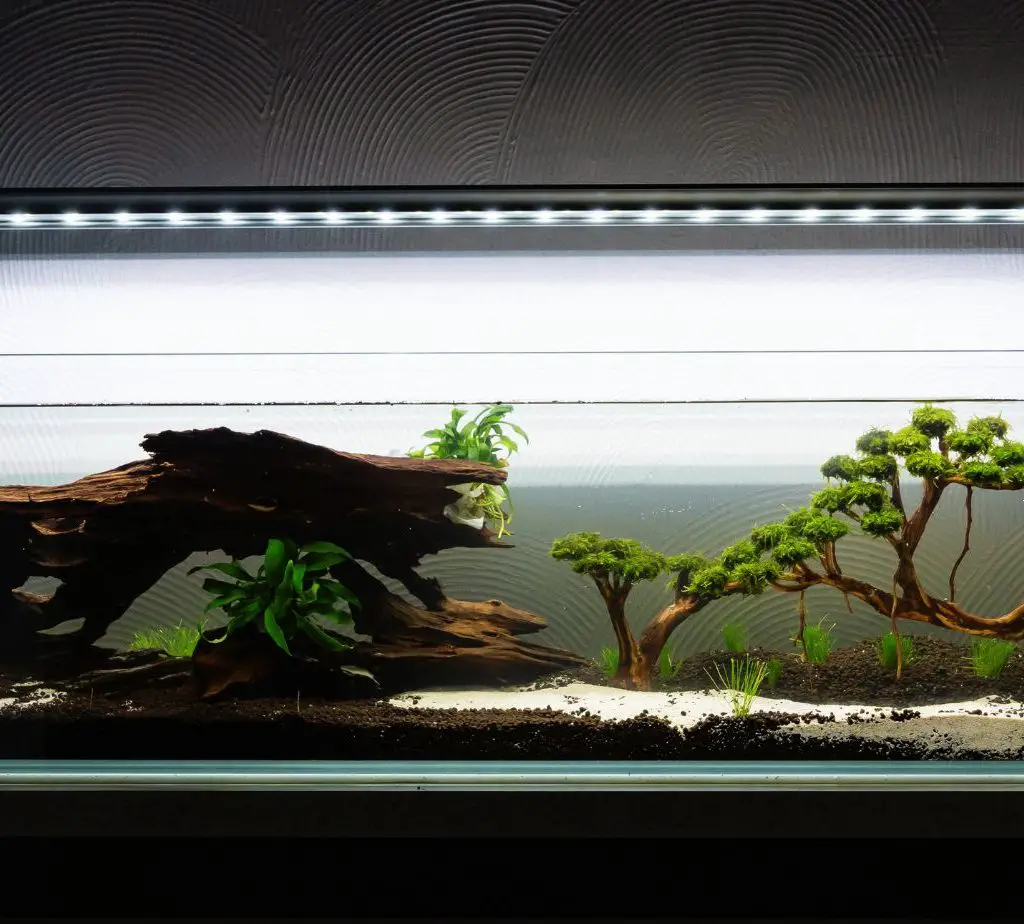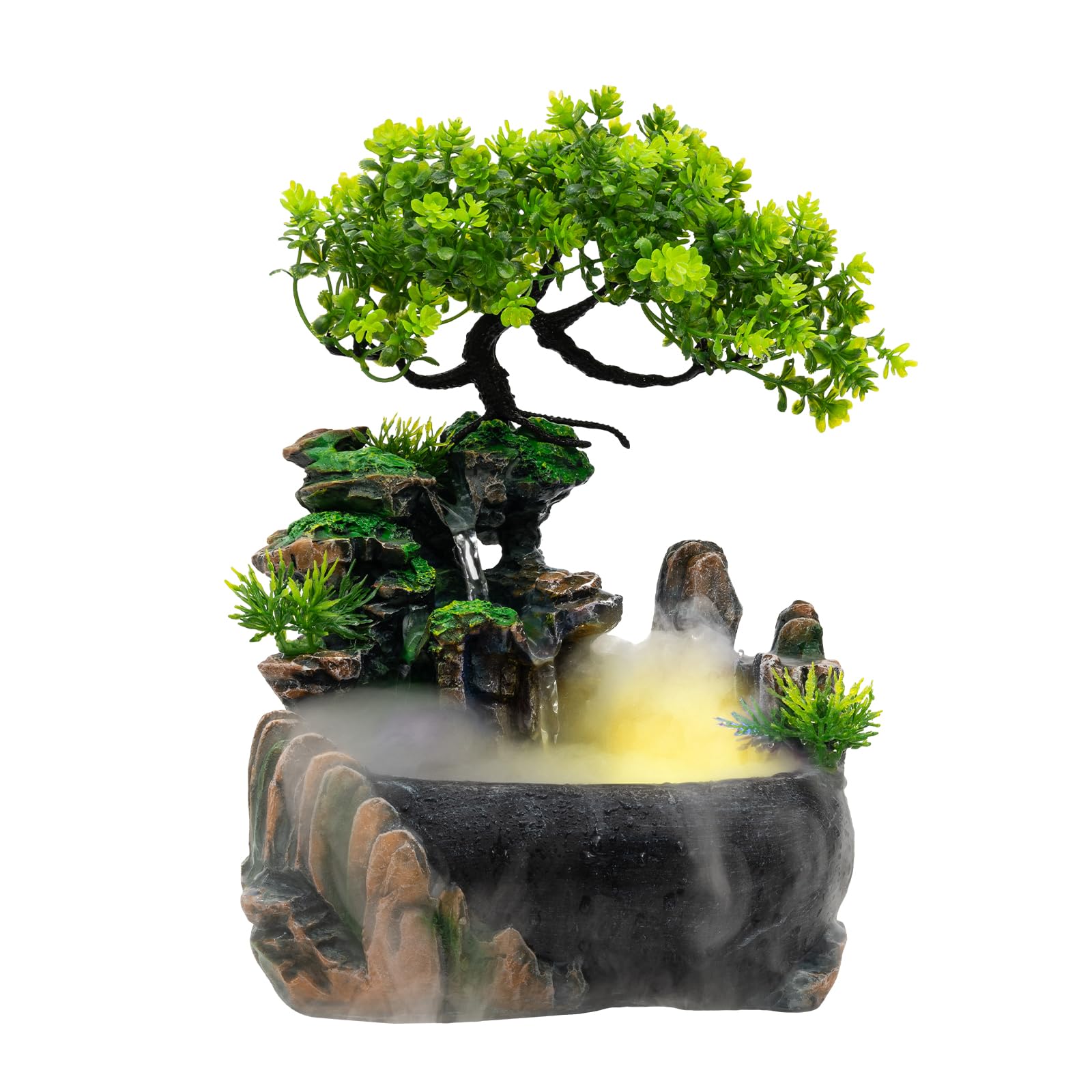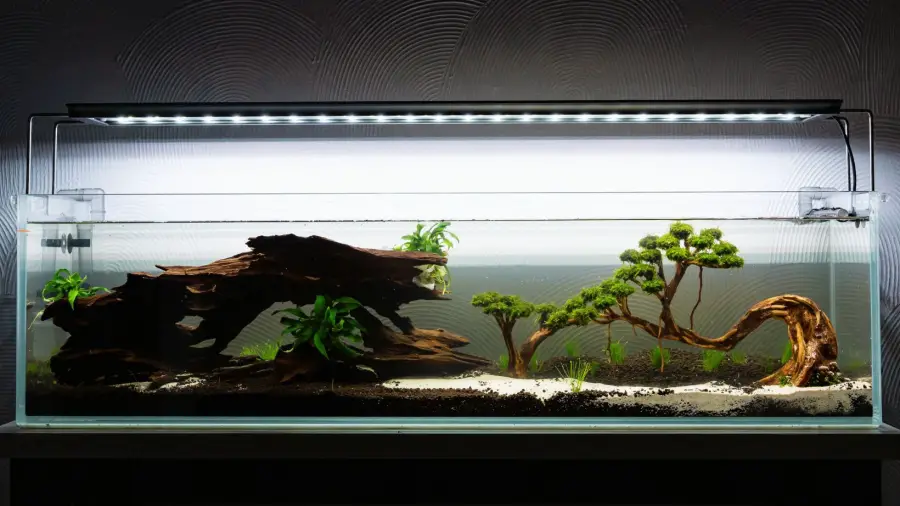Bonsai for aquariums enhance visual aesthetics and provide habitat for aquatic life. They are small, artistically shaped trees submerged in water.
Creating an underwater landscape with bonsai trees can turn an ordinary aquarium into a stunning display that simulates natural environments, offering both beauty and benefits to your aquatic friends. These miniature trees are often made from materials like driftwood or resin, meticulously crafted to resemble real bonsai.

They serve as intriguing focal points, inviting observers to take a closer look. When adding bonsai to your aquarium, not only do you create an extraordinary visual appeal, but you also contribute to the ecosystem by providing shelter and surfaces for beneficial bacteria to colonize. Selecting the right bonsai is essential for both the health of your aquarium inhabitants and the overall design coherence.
Table of Contents
The Fusion Of Bonsai And Aquascaping
Imagine a world where the lush tranquility of a bonsai garden meets the serene flow of an underwater aquascape.
Bonsai for Aquariums creates such a world inside your tank. This practice combines two ancient arts. It forms a stunning visual feast for both enthusiasts and casual observers.
Blending Terrestrial And Aquatic Traditions
The art of integrating bonsai trees with aquatic environments dates back centuries. It honors the Japanese traditions of bonsai and aquascaping.
- Bonsai: Delicate mastery involved in growing miniature trees.
- Aquascaping: Creating underwater landscapes with plants and rocks.
Together, these forms create a harmonious setup where air and water elements merge.
Enhancing The Beauty Of Aquariums With Miniature Trees
Bonsai for aquariums takes the grace of a tiny tree and places it underwater. This blend can be spellbinding. Each element works together to elevate the aesthetic value of your tank.
| Element | Role in Aquarium |
|---|---|
| Miniature Bonsai | Provides a central, eye-catching feature. |
| Aquatic Plants | Enhance the naturalistic appeal around the bonsai. |
| Fish | Add movement and life to the composition. |
When selected and placed thoughtfully, these bonsais become more than a piece of wood. They serve as living sculptures that transform your aquarium.

Credit: www.facebook.com
History Behind Aquarium Bonsai
The intertwining of nature and artistry finds a unique manifestation in the world of aquarium bonsai. This enchanting practice breathes life into aquatic landscapes, invoking the essence of terrestrial woodlands beneath the tranquil surface of water. Aquarium bonsai’s history stems from ancient traditions and modern innovations in the realm of aquascaping.
Origins Of Bonsai Tradition
The art of bonsai, originating in China over a thousand years ago, was perfected in Japan. Bonsai, meaning ‘planted in a container’, involved meticulous care and pruning to create miniature replicas of mature trees. While traditional bonsai grow on dry land, the principles remain rooted in the aesthetic arrangement, harmony, and a profound respect for nature.
Aquascaping Emergence And Innovations
Aquascaping, or underwater gardening, emerged as a distinct art form in the late 20th century. Pioneers like Takashi Amano transformed aquatic landscaping into an art, infusing modern design with the ethos of bonsai. This era birthed the concept of aquarium bonsai, which combines the elegance of bonsai with the fluid dynamics of aquatic ecosystems.
The modern aquarium bonsai practice involves shaping deadwood, known as driftwood, to resemble the ancient bonsai. Aquarists then cultivate aquatic plants, attaching mosses or fine-leaved species to the sculpted wood. These living sculptures create a stunning, zen-like underwater scene.
Choosing The Right Bonsai For Your Aquarium
Imagine a tranquil underwater forest in your home aquarium. Bonsai trees for aquariums make this dream real. They add beauty and balance to your aquatic setup. Yet, choosing the right one is crucial. In this guide, we dive into ideal selections and fitting sizes for your tank. Let’s create an underwater escape that captivates and calms.
Aquatic-safe Bonsai Varieties
Selecting tree variations that thrive underwater is essential. Not all bonsai trees are suitable for submersion. Here’s a selection of favorite aquatic-safe bonsai types:
- Mopani Wood – Known for its unique shapes and durability in water.
- Spider Wood – Offers intricate branches for an elegant underwater scene.
- Malaysian Driftwood – Sinks easily and ideal for anchoring plants.
Sizing And Proportions For Tank Harmony
Bonsai size matters for a well-balanced aquarium. A properly proportioned bonsai complements your tank’s inhabitants and layout. Use these guidelines:
| Tank Size | Recommended Bonsai Size |
|---|---|
| Small Tanks (under 10 gallons) | Mini Bonsai (up to 4 inches) |
| Medium Tanks (10-25 gallons) | Small Bonsai (4-8 inches) |
| Large Tanks (25 gallons and up) | Medium to Large Bonsai (8 inches and up) |
Preparing Bonsai For Submersion
Imagining a miniature underwater forest is dreamy. Aquascapers use bonsai trees to create such ethereal aquascapes. A bonsai brings intricate detail and serenity to aquariums. But how do we prepare these delicate trees for a life under water? Preparing bonsai for submersion involves special techniques. It ensures the wood endures its new aquatic environment. It also helps to foster a robust ecosystem for fish and plants. Let’s dive into the preparation process.
Treatment And Conditioning Techniques
Initial Cleaning:
- Scrub the bonsai to remove dirt.
- Rinse thoroughly with water.
Disinfection:
- Soak in a mix of water and bleach (19:1 ratio).
- Rinse the bonsai multiple times.
Waterlogging:
- Submerge the bonsai in water for several weeks.
- Change water regularly to prevent rot.
Drying:
- Air dry to ensure no moisture pockets remain.
Long-term Maintenance Underwater
Water Checks:
- Monitor water pH and hardness.
- Adjust as necessary for tree preservation.
Aquatic Plant Integration:
- Select plants that complement the wood.
- Anchor mosses and ferns to the bonsai.
Regular Pruning:
- Trim plants to maintain shape.
- Keep the bonsai aesthetic intact.
Observation:
- Check for signs of decay or algae.
- Act quickly to remedy any issues.
Design Principles In Aquatic Bonsai
Design Principles in Aquatic Bonsai form the heart of creating an underwater masterpiece. They dictate not just beauty but also the wellness of aquatic life. A balance of form and function is crucial.
Creating A Miniature Waterscape
The art of aquatic bonsai begins with imagining a miniature waterscape. This takes inspiration from nature’s vast scenery. It’s downsized into a tranquil, aquatic version.
- Choose the right plants: Short, sturdy species simulate trees.
- Substrate selection: Gravel or sand can portray the ground.
- Adding rocks: They are the mountains and cliffs.
- Water flow: A calm flow can mimic gentle breezes.
Balancing Aesthetics With Practicality In Tank Design
Aesthetic appeal is important, but so is practicality. Your aquarium must support life. A balance is key.
| Element | Aesthetic Role | Practical Role |
|---|---|---|
| Lights | Highlight plants and rocks | Support plant growth |
| Filtration | Kept hidden | Keeps water clean |
| Flora | Add color and texture | Provide oxygen |
| Fauna | Bring dynamics | Control algae |

Credit: www.amazon.com
Integrating Fauna With Aquatic Bonsai
Integrating Fauna with Aquatic Bonsai brings to life a miniature underwater world. Combining the Zen-like tranquility of bonsai trees with the lively movement of fish creates a captivating aquatic display. It’s an art form that balances the stillness of flora with the dynamic nature of fauna.
Selecting Fish And Invertebrates
Choosing the right fish and invertebrates for your aquatic bonsai is vital. Not all species coexist peacefully with bonsai roots. Some fish may harm the delicate miniaturized trees. Others may thrive, adding beauty and balance to the underwater scene. Consider the size, temperament, and environmental needs of your aquatic creatures.
- Neon Tetras: Add a splash of color with their vibrant blue and red hues.
- Cherry Shrimp: Known for algae-eating, keeping bonsai leaves clean.
- Siamese Algae Eater: A perfect companion for maintaining the bonsai’s elegance.
Ensuring Compatibility And Safety
Harmony in your aquarium is key. Each species has unique needs. A safe environment for both your bonsai and its aquatic inhabitants ensures thriving life. Water parameters, such as pH and temperature, must match the needs of both.
| Fish/Invertebrate | Preferred pH | Temperature Range (°F/C) |
|---|---|---|
| Neon Tetras | 6.0-7.0 | 70-81°F/21-27°C |
| Cherry Shrimp | 6.5-8.0 | 65-85°F/18-29°C |
| Siamese Algae Eater | 6.5-7.0 | 75-79°F/24-26°C |
Match your plants to the right tank mates. Test water frequently. Create an ecosystem where both plant and animal can flourish.
Common Challenges And Solutions
Creating a thriving aquatic ecosystem with a bonsai can be rewarding. Yet, several common challenges might arise. Expert tips and solutions help overcome these hurdles, ensuring a beautiful and healthy bonsai aquarium setup.
Controlling Algae Growth On Bonsai
Bonsai trees in aquariums can experience unwanted algae growth. This occurs due to excess light or nutrients. Here are steps to keep algae at bay:
- Limit Lighting: Reduce light exposure to 8-10 hours daily.
- Water Quality: Perform regular water changes to maintain nutrient balance.
- Clean Manually: Gently scrub the bonsai with a soft-bristled toothbrush.
- Algae Eaters: Add algae-eating fish or shrimp to your tank ecosystem.
Dealing With Root Rot And Decay
Root rot and decay can damage your aquatic bonsai. To protect your bonsai tree, follow these practices:
| Problem | Solution |
|---|---|
| Poor Circulation | Ensure proper water flow around the roots. |
| Excess Feeding | Feed fish adequately to prevent leftover food. |
| Decomposing Matter | Regularly clean the tank and remove waste. |
| Chemical Balance | Test water parameters and adjust as necessary. |
Showcasing Aquatic Bonsai Creations
Aquatic bonsai are more than just plants; they are underwater art. Showcasing Aquatic Bonsai Creations brings to light the mesmerizing world where aquascaping meets miniature forestry. These living sculptures blend the elegance of bonsai with the serenity of an aquarium, forming a harmony that captivates all who observe.
Community And Competitions
The aquatic bonsai community thrives on creativity and sharing. Enthusiasts often gather at competitions to display their masterpieces. Competitions present an opportunity to learn new techniques and connect with fellow aquarists.
- Bonsai Aquascaping Contests
- Annual Aquatic Gardeners Association Convention
- Online Forums and Social Media Groups
At these events, artists and hobbyists alike showcase their skillfully pruned plants and meticulously crafted landscapes. Judges evaluate creations based on composition, technique, and overall beauty.
Photography And Sharing Online
Digital platforms transform the way aquatic bonsai enthusiasts share their work. High-quality photography brings these underwater landscapes to a global audience.
Various forums and social media platforms provide enthusiasts with places to:
- Display their aquatic bonsai
- Share cultivation tips
- Receive feedback
- Connect with admirers and other artists
Instagram hashtags like #AquaticBonsai and #Aquascaping showcase thousands of bonsais. Such platforms also offer inspiration for those interested in starting their own aquatic bonsai journey.
Caring For Aquatic Bonsai
Imagine a miniature underwater forest in your aquarium. Aquatic bonsai trees transform fish tanks into living art. Like all bonsai, they need specific care to thrive. We will dive into tips for pruning, water chemistry, and nutrient balance.
Trimming And Pruning Techniques
- Use sharp scissors to make clean cuts.
- Trim regularly to shape your bonsai and control growth.
- Prune away dead or yellow leaves to keep the tree healthy.
Pruning is both an art and science. Gently trim the branches to maintain the natural look. Consistent maintenance ensures dense, vibrant foliage.
Water Chemistry And Nutrient Balance
| Water Parameter | Ideal Range |
|---|---|
| pH Level | 6.5 – 7.5 |
| Water Hardness | 3-8 dGH |
| Nutrients | N, P, K, Fe |
Balance is key in water chemistry. Test water regularly and adjust as needed. Bonsai plants require specific nutrients. Use the right fertilizer to promote healthy growth.
Inspirational Aquatic Bonsai Projects
Imagine a miniature underwater forest in your living room. Aquatic bonsai, or the art of crafting underwater tree landscapes, blends aquascaping with traditional bonsai techniques. These enchanting water scenes bring serenity and natural beauty into your aquarium. Let’s dive into the world of aquatic bonsai and explore inspirational projects and expert tips.
Case Studies Of Stunning Water Scapes
Behind every aquatic bonsai, there’s a story of creativity and patience. These case studies highlight remarkable water scapes created by seasoned aquascapers.
- The Zen Grove: A tranquil arrangement of miniature trees over a bed of river stones, replicating a secluded forest.
- Mountain Stream: Featuring water-resistant bonsai perched atop rocky outcrops, mimicking a highland stream.
- The Red Maple Atrium: Showcases a fiery red bonsai, standing out against a backdrop of lush green aquatic plants.
Each of these cases reveals the potential of aquatic bonsai to transform an aquarium into a living piece of art.
Tips From Expert Aquascapers
Expert aquascapers share a treasure trove of tips to help you craft your own aquatic bonsai masterpiece.
| Tip | Detail |
|---|---|
| Choose the Right Bonsai | Select species that thrive underwater, like the Mondo Grass or Baby Tears. |
| Mimic Natural Environments | Incorporate natural elements like rocks and substrate to recreate a realistic habitat. |
| Balance Aesthetics and Health | Ensure proper lighting and nutrients for plant growth without compromising the visual appeal. |
Start with a vision, be patient, and observe how your underwater bonsai garden flourishes.

Credit: www.amazon.com
Frequently Asked Questions For Bonsai For Aquarium
Can Bonsai Trees Live In Aquariums?
Bonsai trees can indeed thrive in aquariums if they are crafted as aquatic bonsai, also known as underwater bonsai. This set up often uses species that are tolerant to saturated conditions, such as the mangrove bonsai.
What Are The Best Bonsai Trees For Aquariums?
The best bonsai for aquariums are typically aquatic species like the mangrove or plants adaptable to underwater growth like the Ficus. Choose species that can handle the consistent moisture and limited light conditions of an aquarium.
How Do You Maintain A Bonsai In An Aquarium?
Maintaining a bonsai in an aquarium involves regular pruning, ensuring proper water conditions, and providing adequate lighting. Use clean and clear water to prevent harmful bacteria and ensure the tree’s health isn’t compromised.
Do Aquarium Bonsais Benefit Fish?
Aquarium bonsais create a natural and enriching environment for fish. They offer hiding places and can help maintain water quality, benefiting both the aesthetic of your aquarium and the well-being of its aquatic inhabitants.
Conclusion
Embracing the art of bonsai within your aquarium isn’t just an aesthetic choice. It’s a journey towards creating a serene underwater scene. This unique fusion enhances both your aquascape and the joy of fishkeeping. Explore this aquatic endeavor; your tank’s tranquility awaits.
Let bonsai transform your aquarium into a living masterpiece.
